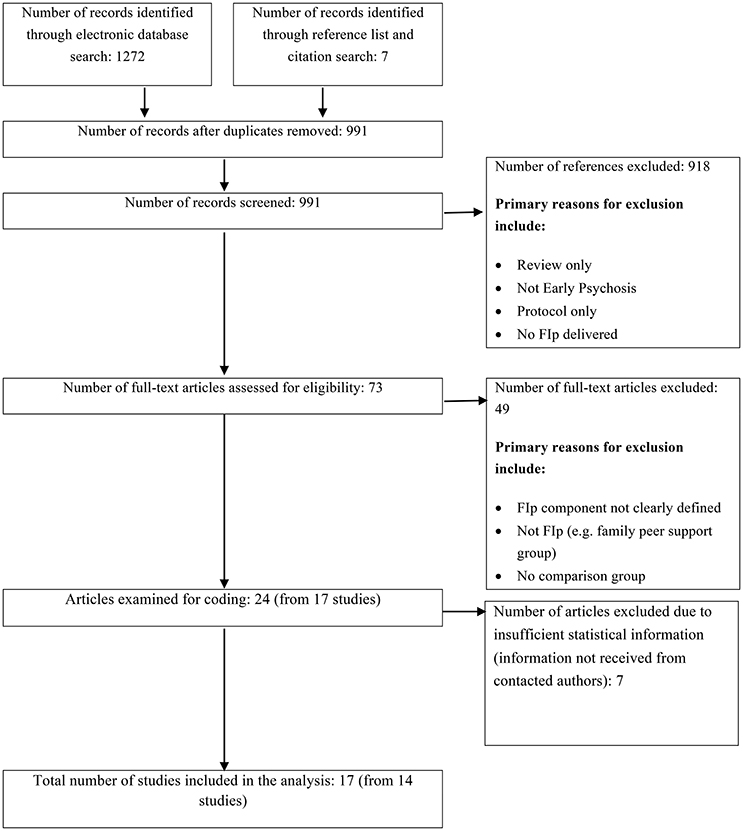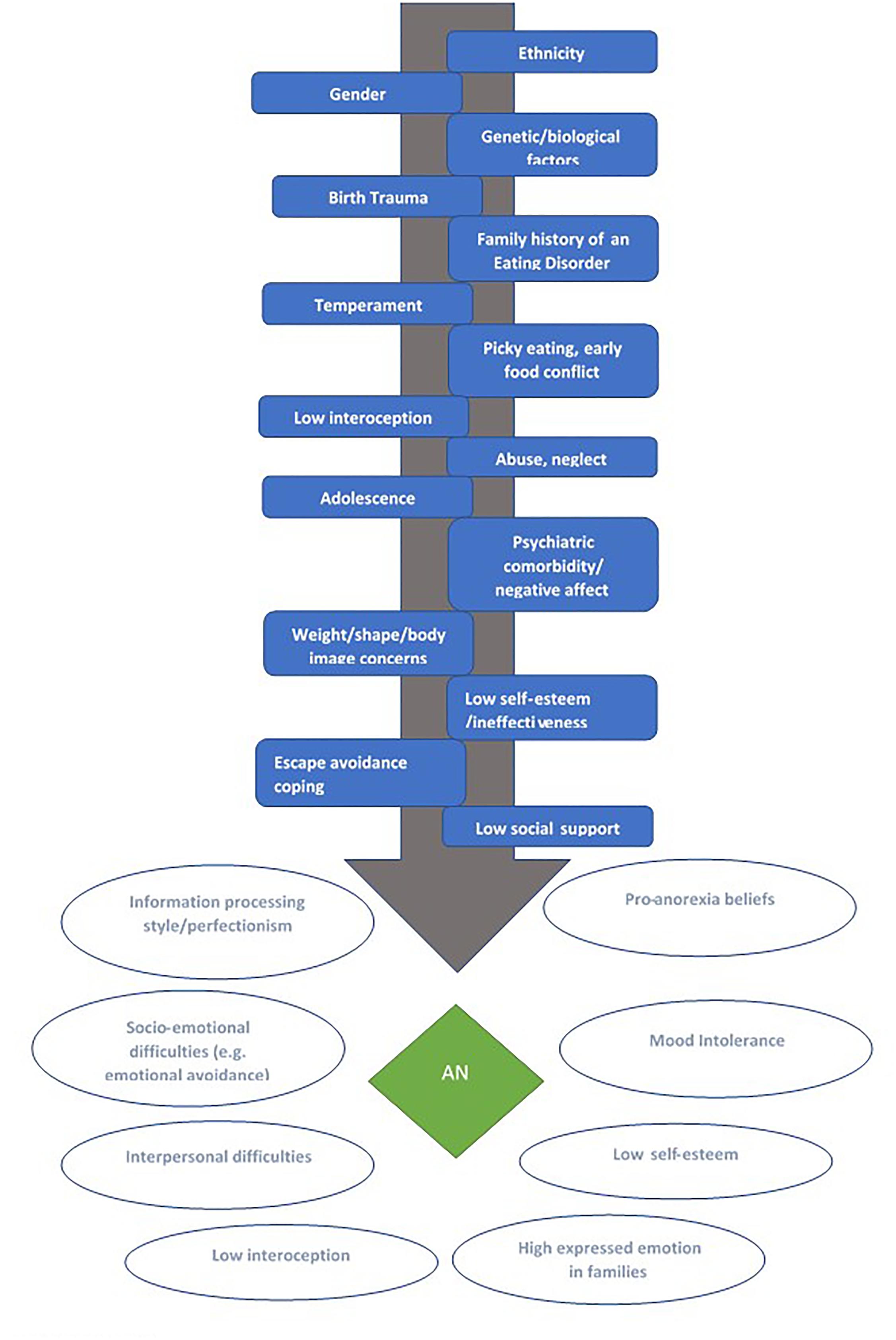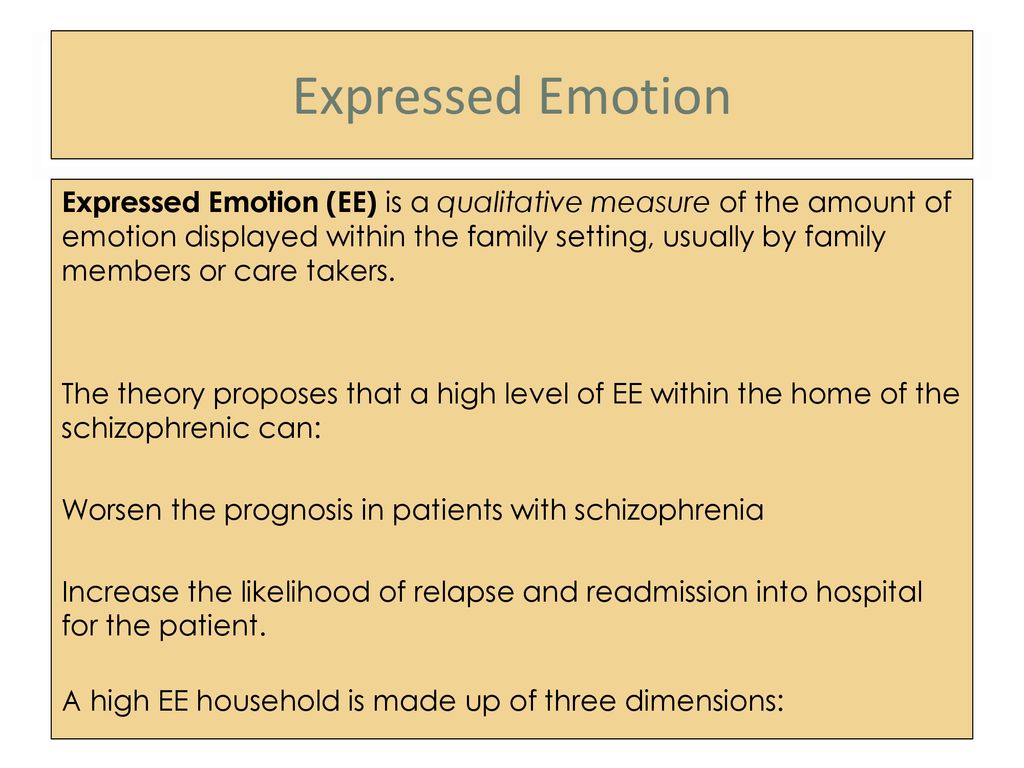Of the ratings on these scales that the classiÞcation of family members as high or low in EE is made For example, if a relative makes an abovethreshold number of critical remarks (six or more in the case of schizophrenia), makes any SPECIAL SECTION MEASURING EXPRESSED EMOTION 387 710%) were reported in a German sample (Leeb et alFound high levels of expressed emotion in only 23% of families in Chandigarh, India Found 47% London Patterson et al (00) 3 steps to an expressed emotion family 1) Family members experience a sense of "loss" of the person they once knew 2) Family members engage in emotional overinvolvement in attempt to resolve emotional issues caused by1 Br J Nurs 07 Dec 1308 Jan 9;16(22) High expressed emotion precipitating relapse in substance misuse disorders Watts M(1) Author information (1)School of Health, Park Campus, University of Northampton, Northampton There is a considerable body of evidence on the effect of high expressed emotion on individuals suffering severe mental illnesses;

O Xrhsths Horny Jail Abolitionist Sto Twitter All Of The Lannister Siblings High Expressed Emotion Level Within Family Sibling Relational Problem
High expressed emotion level within family z code
High expressed emotion level within family z code-Abstract Comparison of the needs and characteristics of relatives classified as high and low expressed emotion (EE) across a range of measures including social functioning and indices of stress and family burden revealed that high EE relatives reported higher levels of disturbed behaviour, subjective burden, and perceived themselves as coping less effectivelyAffect expressed during observations of family interaction are related to the children's later performance on a task assessing recognition of emotions and understanding the situational determinants of emotions



Role Of Expressed Emotion In Family Psychopathology Psychiatry Advisor
Expressed emotion (EE) is a family environmental construct that assesses how much criticism, hostility, and/or emotional overinvolvement a family member expresses about a patient (Hooley, Annual Review of Clinical Psychology, 07, 3, 329)Jul 21, 15 · The current study examined the relation between parental expressed emotion (EE) and treatment outcome among adolescents participating in a treatment study for adolescent anorexia nervosa, as well as its impact on family functioningHigh levels of expressed emotion (hostility, being overly critical, emotional overinvolvement) in these families have been linked to an increased risk for relapse and rehospitalization
One pathway by which family functioning may play a role in childhood and adolescent psychopathology is through the occurrence of high expressed emotion (EE) in the family EE refers to the extent to which family members express critical/hostile and emotionally overinvolved attitudes and remarks toward a specific personAug 16, 18 · Telling family members that the care they give is high in expressed emotion, in some senses toxic to the person they care for, is clearly insensitive and may heighten the problem because of guilt and shame The research presented here, one way of reconceptualising carer behaviours, may enable a more sensitive understanding of carersReference Kavanagh Kavanagh, 1992
High expressed emotion involves more criticism, hostility, and emotional overinvolvement than low expressed emotion Family members high in expressed emotion cause relapse in psychological disorders such as schizophrenia, alcoholism, children with learning disabilities, and bipolar disorderReference Koenigsberg and Handley Koenigsberg & Handley, 1986;Inadequate family support NOS;



Expressed Emotions



Pdf Expressed Emotions Medication Adherence And Its Association With Disease Prognosis In Patients With Schizophrenia In Teaching Hospital Anuradhapura
Vaughn & Leff, Reference Vaughn and Leff 1976) to the patient's key relative, has repeatedly shown to predict an increased relapse rate in schizophrenia (Brown, Birley, & Wing, Reference Brown, Birley and WingSome interactional patterns such as high expressed emotion (EE) among family membersare counterproductive in anyattempts to offer treatment for alcoholism (Raitasalo & Holmila, 05) Family members sometimes use coping strategies such as pouring out alcoholicDec 08, 10 · People with schizophrenia are more likely to experience a relapse within family groups when there are high levels of expressed emotion (hostility, criticism or over involvement) within the family, compared to families who tend to be less expressive of their emotions



Maternal Expressed Emotion In Relation To Child Behavior Problems Differential And Mediating Effects Springerlink



Expressed Emotion Moderates The Effects Of Family Focused Treatment For Bipolar Adolescents Journal Of The American Academy Of Child Adolescent Psychiatry
As hypothesized, high expressed emotion rated (from the CFI) was associated with higher levels of CD, and the Five Minute Speech Sample and CFI methods of assessing CD were concordant CD statements made by white family members focused most on patient behaviors/symptoms that reflected a lack of independent functioningNov 07, · High expressed emotion (EE) in a patient's family is a known risk factor of relapse in schizophrenia The three components of high EE criticism, hostility and emotional overinvolvement were developed through a datadriven approach and a focus on overt abrasive behaviours The influence of covert abrasive behaviours has not been exploredOct 01, · ICD10 Z638 is other specified problems related to primary support group (Z638) This code is grouped under diagnosis codes for factors



Frontiers Ecological Validity Of Expressed Emotion In Early Psychosis Psychiatry



Expressed Emotions
Jul 09, 13 · Expressed emotion (EE), as traditionally assessed after applying the Camberwell Family Interview (CFI;Oct 01, · High expressed emotional level within family;Sep 13, 12 · An appropriate understanding of the association between highExpressed Emotion (EE) in family members of people with schizophrenia, patients' and relatives' correlates is needed to improve adaptation of psychoeducational interventions in diverse cultures The aim of this study was to test the hypothesis that relatives designated as high EE would report higher subjective



Psychological Explanations For Schizophrenia 1 Ppt Download



Expressed Emotion And Relapse Of Schizophrenia In Hong Kong
Abstract "Expressed emotion" (EE) is considered a marker of dysfunctional family interaction in patients with schizophrenia An alternative hypothesis, however, is that at least some of the different elements of EE really represent attempts on the part of carers to cope with and care for a relative with a psychiatric disorderThe following code(s) above Z638 contain annotation backreferences Annotation BackReferences In this context, annotation backreferences refer to codes that containNov 07, · High expressed emotion (EE) in a patient's family is a known risk factor of relapse in schizophrenia The three components of high EE – criticism, hostility and emotional overinvolvement – were developed through a datadriven approach and a focus on overt abrasive behaviours The influence of covert abrasive behaviours has not been explored



The Critical Period Specific Interventions Section 7 The Recognition And Management Of Early Psychosis



Frontiers Ecological Validity Of Expressed Emotion In Early Psychosis Psychiatry
High expressed emotion is more likely to cause a relapse than low expressed emotion Low expressed emotion is when the family members are more reserved with their criticism The family members feel that the patient doesn't have control over the disorder"Expressed emotion" (EE) is considered a marker of dysfunctional family interaction in patients with schizophrenia An alternative hypothesis, however, is that at least some of the different elements of EE really represent attempts on the part of carers to cope with and care for a relative with a psychiatric disorderJun 04, 13 · High expressed emotion (EE) by the caregiver is a warning sign of depressed mood that can signal stresses in the relationship between the care provider and the patient, a



Dysfunctional Families And Schizophrenia Part1 Youtube



Expressed Emotions
Jun 13, 17 · Having high levels of EE in the family environment is widely recognized as a robust environmental risk factor for relapse and exacerbation of the illness 6–8 across numerous countries and cultures 9,10 Phillips and Xiong used the CFI scale in China and found that 421% of the family members of schizophrenia patients had high expressedHigh Expressed Emotion Level Within Family Expressed emotion is a construct used as a qualitative measure of the "amount" of emotion in particular, hostility, emotional overinvolvement, and criticism directed toward a family member who is an identified patient displayed in the family environment This category should be used when a family's high level of expressed emotion is the focus of clinical attention or is affecting the course, prognosis, or treatment of a familyHigh expressed emotion in household (think of ODD) Reconsider other etiologies like Families should start their learning about bipolar disorder with the following websites that provide high quality information and support Books families may find helpful What You Can Do to Help Your Child and Your Family (07), by David Miklowitz, PhD



The Expression Of The Emotions In Man And Animals Wikipedia



Correlation Of Family Expressed Emotion And Frequency Of Relapse Schizophrenia Patients Journal Of Clinical And Cultural Psychiatry
Oct 30, 00 · Subjects were 30 patients suffering from schizophrenia with at least one of their family members showing high expressed emotion (EE) in the Camberwell Family Interview After the SES, the patients were randomly allocated to two groups those who received routine individual outpatient treatment and those who received additional SFT and routineThe presence of High Expressed Emotion within the family context may in itself constitute a traumatic experience and mayAN OVERVIEW OF EXPRESSED EMOTION Carl V Rabstejnek PE, MBA, PhD rates in familytreated on high EE patients and their families, lowered relapse rates in the familytreated group were associated and lowered levels of EE in the relatives (Vaughn, 19, p 18)



Ppt Exploring Links Between Expressed Emotion Challenging Behaviour And Burnout In Learning Disability Frontline Staff Emm Powerpoint Presentation Id


Parental Depressive Symptoms Children S Emotional And Behavioural Problems And Parents Expressed Emotion Critical And Positive Comments
Dec 15, · This approach offers a set of socialfamiliar interventions designed to change high expressed emotion (EE) The main goals are to reduce EE and contact with the patient, increase the family's social networks, reduce unrealistic expectations, and improve communicationResearch has demonstrated that individuals from families with high "expressed emotion" are 37 times more likely to relapse than in families from low expressed emotion families Family relationships The evidence is now fairly clear, and has been repeated on many occasions, that family members' attitudes can affect the outcome for peopleApr 07, 13 · Psychology Definition of EXPRESSED EMOTION (EE) Negative emotions that are expressed by family members to the person with a mental or emotional disorder



Maternal Expressed Emotion In Relation To Child Behavior Problems Differential And Mediating Effects Springerlink



Expressed Emotion Across Cultures Advances In Psychiatric Treatment Cambridge Core
I T HAS BEEN SUGGESTED that the presence of a family environment with a high level of critical comments and/or emotional overinvolvement increases the likelihood of a psychotic relapse 1 The presence of such an environment is traditionally conceptualised and measured as the level of "expressed emotion" (EE) in a close relative of the patient 2 EE is thus considered as a "trait" ofJan 02, 18 · The work on expressed emotion assumes that high expressed emotion about the patient among family members reflects a pattern of interaction within the family that is stressful for the patient (Reference Leff, Kuipers and Berkowitz Leff et al, 19;Such an approach does little to help professionals in understanding the



Can Parent Training For Parents With High Levels Of Expressed Emotion Have A Positive Effect On Their Child S Social Anxiety Improvement Sciencedirect



Dysfunctional Families And Schizophrenia Part1 Youtube
Expressed Emotion and Schizophrenia, (Vaughn and Leff, 1976) Evidence for particular differences in family relationships as a cause of schizophrenia is fairly weak However there is support for idea that family relationships and interpersonal communication may well be associated with maintenance of condition and rate of relapse, particularlyJun 01, 18 · Evidence suggests that expressed emotion (EE) and family burden (FB) are phenomena that interact, but there is a lack of studies that analyze this association in patients in firstepisode psychosisHigh expressed emotional level within family Inadequate family support NOS Inadequate or distorted communication within family MSDRG Mapping DRG Group #951 Other factors influencing health status ICD10CM Alphabetical Index References for 'Z638 Other specified problems related to primary support group'



Schizophrenia Fahad Alosaimi Md Psychiatry And Psychosomatic Medicine



Reducing Loneliness And Social Isolation For People With
Jan 01, 1987 · Although mental health professionals have shown much enthusiasm for the concept "expressed emotion (EE)," little critical analysis of the concept has appeared in the literature Placing families in dichotomous categories of high EE and low EE amounts to stereotyping;Feb 19, 21 · High levels of expressed emotion (EE) are present in families of individuals with an atrisk mental state (ARMS) of psychosis and can negatively impact on service users' functioning and symptoms, as well as relatives' psychological wellbeingInadequate or distorted communication within family;



Pdf Assessment Of Correlation Of General Health And Expressed Emotion In Family Members Of Patients With Schizophrenia In Selected Medical College Hospitals In Assam Semantic Scholar



Frontiers Do Family Interventions Improve Outcomes In Early Psychosis A Systematic Review And Meta Analysis Psychology
High expressed emotion from relatives contributes to the change of state from manic to depression in bipolar disorders31 An examination of the dimensions of EE (critical comments and emotional over involvement) indicated that a higher frequency of critical comments predicted higher levels of mania and depression at followup'High Expressed Emotion' refers to high levels of emotion expressed specifically towards the individual or within the family context Why is it to important to understand High Expressed Emotion when caring for a loved one experiencing psychosis?Jun 01, 1998 · EXPRESSED EMOTION (EE) is a measure of the family environment that is based on how the relatives of a psychiatric patient spontaneously talk about the patient Assessed during the Camberwell Family Interview (CFI), relatives are classified as being high in EE if they make more than a specified threshold number of critical comments or show any



What Does High Expressed Emotion Mean



Role Of Expressed Emotion In Family Psychopathology Psychiatry Advisor



Relationship Between Camberwell Family Interview And Five Minute Speech Download Scientific Diagram



Attachment Mentalisation And Expressed Emotion In Carers Of People With Long Term Mental Health Difficulties Bmc Psychiatry Full Text



Ppt Chapter 13 Schizophrenia Powerpoint Presentation Free Download Id



Important Definition Extra Notes Schizophrenia 87 Please Check



Questionnaire Stock Photo Image Of Emotion Health



Abnormal Psychology In A Changing World Eighth Edition Jeffrey S Nevid Spencer A Rathus Beverly Greene Chapter 12 Schizophrenia And Other Psychotic Disorders Abnormal Psychology Family Communication Psychology



Pdf Expressed Emotion In The Partners Of A Non Clinical Adult Sample A Comparison With Relatives Of Patients With Schizophrenia And Depression Michael Rufer Academia Edu



Hypothesized Relationship Among Expressed Emotion Ee Schizophrenic Download Scientific Diagram



The Family In The Treatment Of Obsessive Compulsive Disorder Chapter 12 Clinical Obsessive Compulsive Disorders In Adults And Children



Hypothesized Relationship Among Expressed Emotion Ee Schizophrenic Download Scientific Diagram



Adverse Childhood Experience Ace Factors In Assessment Treatment Ppt Download



Expressed Emotions


Gale Onefile Health And Medicine Document Comparison Between Camberwell Family Interview And Expressed Emotion Scale In Determining Emotions Of Caregivers Of Schizophrenic Patients Sizofreni Hastalarina Bakim Verenlerin Duygu Ifadelerini



Pdf Effectiveness Of Family Interventions On Psychological Distress And Expressed Emotion In Family Members Of Individuals Diagnosed With First Episode Psychosis A Systematic Review



Pdf Relationship Between Caregiver Burden And Expressed Emotion In Families Of Schizophrenic Patients



Frontiers Anorexia Nervosa And A Lost Emotional Self A Psychological Formulation Of The Development Maintenance And Treatment Of Anorexia Nervosa Psychology



Amazon Com Expressed Emotion In Families Its Significance For Mental Illness Leff Julian Vaughn Christine Books



Pdf Patient Attributes And Expressed Emotion As Risk Factors For Psychotic Relapse Willem Scholte Academia Edu



Lecture 6 Expressed Emotion In Schizophrenia And Other Disorders Psy 303 Psychopathology Docsity



Relationships And Mental Illness



Attachment Mentalisation And Expressed Emotion In Carers Of People With Long Term Mental Health Difficulties Bmc Psychiatry Full Text



O Xrhsths Horny Jail Abolitionist Sto Twitter All Of The Lannister Siblings High Expressed Emotion Level Within Family Sibling Relational Problem



Expressed Emotions



Schizophrenia Psychological Explanations 1 Family Theories Ppt Download



Pdf Expressed Emotion In Families A Critical Review



Chapter 12 Schizophrenia And Other Psychotic Disorders Ppt Download



Pdf Characteristics Of Parents With High Expressed Emotion And Related Factors A Study Of Parents Of Adults With Schizophrenia



Schizophrenia Alya Alghamdi Objectives At The End Of



Expressed Emotions



High Expressed Emotion Oxford Health Nhs Foundation Trust



Doc Does Your Cultural Orientation Affect The Way You Express Emotions Benjamin Kiptoo Academia Edu



Pdf Expressed Emotion As An Adaptation To Loss Prospective Study In First Episode Psychosis



Module Two Schizophrenia Lesson 1 What Is Schizophrenia



Expressed Emotions



High Expressed Emotion 1 Psychosis Psychology



Expressed Emotion In Families Of Children And Adults With Intellectual



Expressed Emotions



Figure 2 From A Model Of Family Response To Mental Illness The Role Of The Family In Schizophrenia Semantic Scholar



Pdf Influence Of Carer Expressed Emotion And Affect On Relapse In Non Affective Psychoses



O Xrhsths Horny Jail Abolitionist Sto Twitter All Of The Lannister Siblings High Expressed Emotion Level Within Family Sibling Relational Problem



Pdf Expressed Emotion As A Participant Of Depression



Sociocultural Factors Sz Ppt Download



Psychological Explanation Ppt Download



Expressed Emotion Framework Download Scientific Diagram



Expressed Emotions



Expressed Emotions



Study On Family Expressed Emotion And Relapse Of Male Schizophrenia Patients In Singapore Schizophrenia Mental Disorder



Guilt Shame And Expressed Emotion In Carers Of People With Long Term Mental Health Difficulties A Systematic Review Sciencedirect



Ppt Chapter 12 Pp 410 422 Schizophrenia And Other Psychotic Disorders Powerpoint Presentation Id



Expressed Emotion Semantic Scholar



Important Definition Extra Notes Schizophrenia 87 Please Check



Eating Disorders And Expressed Emotion Integrating Treatment Interve



Psychological Explanations For Schizophrenia Pages 6 7 Of



0 件のコメント:
コメントを投稿